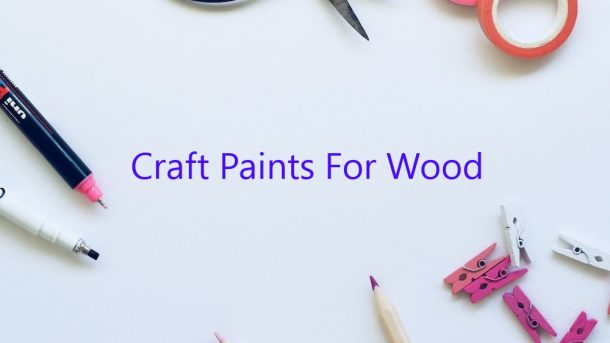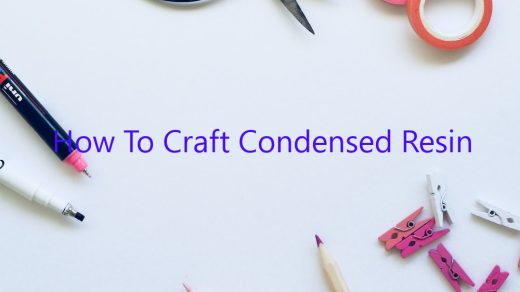Craft paints come in a variety of colors and finishes, making them perfect for a variety of woodworking projects. There are many different brands of craft paints available, so it is important to do some research before selecting the right type of paint for your needs.
When choosing a craft paint for woodworking projects, it is important to consider the type of wood you will be using the paint on. Some paints are better suited for use on hardwoods, while others are better for use on softer woods. In addition, you should consider the finish you want the paint to have. Some paints have a glossy finish, while others have a more matte finish.
One of the most popular brands of craft paint for woodworking projects is FolkArt. FolkArt offers a wide range of colors and finishes, making it a great choice for a variety of projects. In addition, FolkArt paint is non-toxic, making it a safe choice for children’s projects.
Another popular brand of craft paint for woodworking projects is Apple Barrel. Apple Barrel paint is available in a wide range of colors, and it dries to a satin finish. This paint is also non-toxic, making it a safe choice for children’s projects.
If you are looking for a craft paint with a high gloss finish, then PodgeCraft paint is a good choice. PodgeCraft offers a wide range of colors, and the paint dries to a high gloss finish.
Before starting your next woodworking project, be sure to take into account the type of wood you will be using, the finish you want the paint to have, and the brand of craft paint that will best suit your needs.
Contents
What kind of paint do you use on wood crafts?
When it comes to painting wood crafts, there are a few different things you need to consider. The first is the type of wood you’re using. Not all types of wood are created equal, and some will take paint better than others. The next thing to consider is the paint itself. There are a variety of paints available on the market, and not all of them are meant for wood crafts. Finally, you need to decide what type of finish you want on your wood crafts. There are a variety of finishes available, and each has its own benefits and drawbacks.
When it comes to the type of wood you’re using, there are three main options: hardwood, softwood, and plywood. Hardwood is the strongest and most durable type of wood, while softwood is the weakest and least durable. Plywood is a type of softwood that is made up of multiple layers of wood, which makes it stronger than regular softwood.
When it comes to paint, there are three main types: acrylic, latex, and enamel. Acrylic paint is the most popular type of paint, and it is available in both matte and glossy finishes. Latex paint is a type of acrylic paint that is easy to apply and is available in a variety of colors. Enamel paint is a type of paint that is durable and has a high gloss finish.
Finally, you need to decide what type of finish you want on your wood crafts. There are a variety of finishes available, and each has its own benefits and drawbacks. The most common finishes are matte, satin, semi-gloss, and gloss. Matte finishes are the most popular type of finish, and they are available in both acrylic and latex paints. Satin finishes are available in both acrylic and latex paints, and they are a good choice for projects that will be used in high-traffic areas. Semi-gloss finishes are available in both acrylic and latex paints, and they are a good choice for projects that will be used in areas that are exposed to moisture. Gloss finishes are available in both acrylic and latex paints, and they are a good choice for projects that will be used in high-traffic areas.
What paint works best on wood?
There are many different types of paint that can be used on wood, but not all paints are created equal. Some paints will last longer and look better on wood than others.
When it comes to paint for wood, there are two main types of paint to choose from: oil-based paint or latex paint. Latex paint is a water-based paint, while oil-based paint is an alkyd paint. There are pros and cons to both types of paint, but in general, latex paint is a better choice for most wood projects.
Latex paint is more durable and less susceptible to moisture damage than oil-based paint. It is also easier to clean up and does not require the use of any harsh chemicals. Latex paint also dries faster than oil-based paint, so it is less likely to streak or drip.
However, latex paint is not as durable as oil-based paint and it can also fade in direct sunlight. It is also not as resistant to staining as oil-based paint.
If you are looking for the most durable paint for wood, then oil-based paint is the best option. It is more resistant to moisture damage and staining, and it also lasts longer than latex paint. However, oil-based paint is more difficult to clean up and it takes longer to dry.
In general, latex paint is a better choice for most wood projects. It is more durable, easy to clean up, and dries quickly. However, if you are looking for the most durable paint for wood, then oil-based paint is the better option.
Will craft paint work on wood?
When it comes to painting, there are a variety of different types of paint that can be used, depending on the desired effect. One type of paint that is often used for crafting is craft paint. Craft paint is available in a variety of different colors, and it is designed to be used on a variety of different surfaces, including wood.
So, the question is, will craft paint work on wood? The answer is yes, craft paint will work on wood. However, it is important to note that the finished look may not be as durable as if a different type of paint was used. Additionally, craft paint is not typically designed to be used on items that will be used outdoors, such as garden furniture.
If you are looking to paint a piece of wood, and you are looking for a durable finish that will last, it is best to use a different type of paint, such as an outdoor paint. However, if you are looking for a quick, easy way to give a piece of wood a new look, craft paint is a good option.
What is the difference between craft paint and acrylic paint?
Craft paint is designed for use on light-colored, porous surfaces such as wood, paper, fabric, and ceramics. It is available in a wide range of colors and finishes, and is typically less expensive than acrylic paint.
Acrylic paint is a water-based paint that can be used on a variety of surfaces, including canvas, paper, metal, and plastic. It is available in a wide range of colors and finishes, and is typically more expensive than craft paint.
Does acrylic paint stick to wood?
When it comes to painting, there are a variety of different mediums to choose from. Each medium has its own set of pros and cons, and each artist has their own preference. When it comes to acrylic paint, one of the most common questions is whether or not it sticks to wood.
The short answer is yes, acrylic paint does stick to wood. However, there are a few things you should keep in mind when painting on wood with acrylics.
The first thing to consider is the type of wood you’re using. Hardwoods like oak or mahogany are generally better suited for painting than softwoods like pine. This is because the softer woods are more likely to absorb the paint, which can lead to a dull finish.
Another thing to keep in mind is the age of the wood. If the wood is brand new, it will be more absorbent than wood that has been exposed to the elements for a while. So if you’re planning to paint an old piece of wood, you may want to give it a coat of primer first to help the paint stick.
Finally, it’s important to use the right type of paint. Not all acrylic paints are created equal, and some are better suited for painting on wood than others. A good rule of thumb is to use an acrylic paint that is specifically designed for outdoor use, like FolkArt Outdoor Acrylics. This type of paint is weatherproof and will hold up better in the elements.
With these tips in mind, you should be able to paint on wood with acrylics with no problems. Just be sure to test the paint on a small piece of wood first to make sure it adheres properly. Happy painting!
Does acrylic paint on wood need to be sealed?
When painting wood, you may want to use acrylic paint. Acrylic paint is a great option because it is water-based and relatively easy to use. However, one question that may come up is whether or not you need to seal acrylic paint on wood. The answer is not necessarily straightforward, as there are a few factors to consider.
One thing to keep in mind is that not all types of wood need to be sealed. If you are painting a hardwood, such as oak or cherry, you may not need to seal the paint. However, if you are painting a softer wood, such as pine, you may want to seal the paint to protect it from moisture and staining.
If you do decide to seal the paint, there are a few different options. One option is to use a sealant designed specifically for wood. Another option is to use a sealant designed for acrylic paint. However, you should keep in mind that not all sealants are created equal. Some sealants may not be compatible with acrylic paint, so it is important to do your research before selecting a sealant.
Ultimately, the decision of whether or not to seal acrylic paint on wood is up to the individual painter. However, if you are unsure whether or not to seal the paint, it is best to err on the side of caution and seal it. This will help protect the paint from moisture and staining, and will help ensure that your paint job lasts for years to come.
Does acrylic paint stay on wood?
There are a variety of factors to consider when trying to answer the question “does acrylic paint stay on wood?” The first consideration is the type of wood. Hardwoods, such as oak, are more durable and less absorbent than softwoods, such as pine. The second consideration is the paint itself. Acrylic paint is less likely to seep into the wood than oil-based paint, but it is also less durable. The third consideration is the finish of the paint. A gloss finish is less likely to seep into the wood than a matte finish. The fourth consideration is the age of the paint. The older the paint, the more likely it is to seep into the wood.




